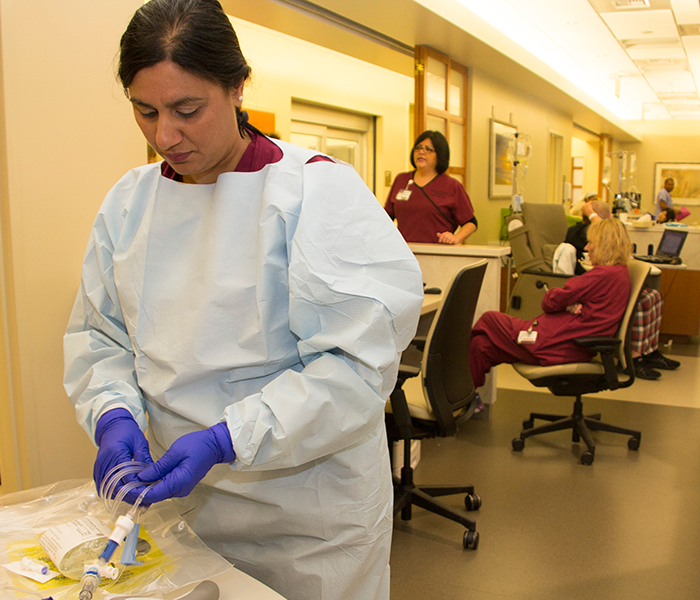5-Fluorouracil, or most commonly referred to as simply 5-FU, is a cytotoxic chemotherapy drug that is classified as an antimetabolite and, within that class, belongs to the pyrimidine analogue family. Antimetabolites are similar to nucleotides that compose DNA and RNA. Because those drugs are so similar to the normal substances in the body's cells, they essentially trick the body and are mistaken for the natural nucleotide bases. However, when they're metabolized, the cell is unable to divide and replicate, thereby stopping growth. It's important to know that 5-FU is considered a pyrimidine antagonist—this distinction tells you which particular natural substance it interferes with: in this case pyrimidines (the building blocks of DNA).
Additional Quick Tips for 5-FU
- Avoid sun exposure.
- Wear SPF15 or higher sunblock because of photosensitivity.
- Modify activities of daily living to decrease friction and heat exposure to hands and feet to prevent hand-foot syndrome (e.g., skip dish duty!)
- Keep hands and feet moist with emollients.
5-FU is approved for a number of cancer diagnoses, including breast, colon, rectal, pancreatic, and gastric (stomach) cancers. 5-FU is also available in a cream formulation that is used for the treatment of actinic keratoses and superficial basal cell carcinomas when conventional methods (i.e., surgical removal) are impractical. Although you will not deal with this in the infusion area, in the topical preparation, a thin coating is commonly applied to affected skin lesions twice per day. Treatment may continue over several weeks.
However, 5-FU is typically given as an injection into the vein, as a slow IV push, or as an infusion. It is considered an irritant, not a vesicant. You will frequently see this drug when treating patients with colon or rectal carcinomas. The infusion is commonly set up as continuous, in which the patient will be hooked up to small pump (about the size of a Walkman, if you're old enough to know that reference!). The pump is programmed to infuse chemotherapy very slowly, administering a few milliliters every hour to last for 46–48 hours. This is part of the very common FOLFOX regimen. The second "F" (FOLFOX) stands for fluorouracil. If you read the previous post in this series, you'll recognize the "OX" as oxaliplatin. I'll get to the first few letters, "FOL," in my next post (spoiler alert!).
How to Infuse 5-FU
So let's walk through a patient case scenario, in case you have not administered the regimen yet. There's a patient getting FOLFOX on your schedule. You grab D5W as your fluids (see my oxaliplatin post for rationale) and infuse your premedications per orders. After premedications, you start oxaliplatin and leucovorin, which you will "y" into the line so that both drugs infuse simultaneously over two hours. After the oxaliplatin and leucovorin infusions are complete, you will administer the 5-FU injection as a slow IV push over several minutes. Finally, you will hook up the 5-FU continuous infusion administered through a small pump to the patient's central line and set the rate to infuse over 46–48 hours as directed per the orders. And poof! You've just administered FOLFOX. It's really not as complicated as it may sound if you're new and have never given the treatment. Do not fret; you will have plenty of practice because this treatment racks up significant frequent flyer miles on most outpatient infusion areas' schedules.
Manage 5-FU's Side Effects
Now that you know how to administer the drug, let's talk about side effects. The most common (greater than 30%) side effects seen with 5-FU are diarrhea, nausea (and possibly occasional vomiting), mouth sores, anorexia, watery eyes, sensitivity to light, taste changes, metallic taste in mouth during infusion, discoloration along the vein used for administration, and myelosuppression (WBC, RBC, Plt) with nadir occurring around days 9–14.
Less common side effects (10%–29%) include dry, cracking, peeling skin; darkening of the skin; radiation recall (darkening of skin where previous radiation was given); hair thinning; nail discoloration; loss of nails (although this is rare); skin rash; swelling; redness; and pain and/or peeling of the skin on the palms of hands and soles of feet (i.e., hand-foot syndrome).
Although very rare, serious cardiac side effects can occur with 5-FU treatment, including chest pain, electrocardiogram changes, and increased cardiac enzymes. Although these potential issues are uncommon, it is certainly something to keep in mind, particularly for patients with a history of heart disease.
The top three side effects that typically pop into my mind when I think about 5-FU are diarrhea, mouth sores, and skin issues/hand-foot syndrome. For patients experiencing diarrhea, confirm that they have over-the-counter antidiarrhea medications on hand at home. Instruct them to call if diarrhea is not controlled or persists and to take in extra fluids to avoid dehydration.
As long as your patients are not receiving oxaliplatin with their 5-FU treatment, mouth sores may be prevented, or at least reduced in severity, by performing one simple nursing measure during administration: cryotherapy. Have your patients hold ice chips in their mouths for about 10–15 minutes before, during, and after the slow IV push of 5-FU. The idea is that the cold ice will constrict the blood vessels in the mouth so that less chemotherapy will be circulating through the oral cavity (where you don't need it), hence preventing or decreasing the severity of mucositis. Sound too good to be true? If you visit the Putting Evidence Into Practice resources on the ONS website, you'll find cryotherapy listed as a recommended for practice intervention to prevent and lessen mucositis. Translation—it works!
Cryotherapy is inexpensive, easy to perform, and will not interfere with 5-FU's efficacy. As such, it should be considered a nursing no-brainer. Remember to use cryotherapy with every patient for whom you are administering 5-FU as a slow IV push (unless receiving with oxaliplatin—then, "ixnay on the ice, okay?"). If your patients develop mouth sores, encourage them to initiate an oral care protocol that focuses on good oral hygiene, using a soft toothbrush, avoiding alcohol-based mouthwashes, and rinsing their mouths with a mixture of baking soda and salt with warm water multiple times per day. The National Cancer Institute recommends mixing 1 cup of warm water with 1/4 teaspoon baking soda and 1/8 teaspoon salt. Swish the rinse around in the mouth, spit, then rinse with plain water; repeat every three hours during the day. Other protocols use 1/2 teaspoon each of salt and baking soda with 1 cup of warm water. Check with your institution, and adhere to your practice's standards. The key with any oral care protocol is consistent use.
As for skin changes, you certainly will see discoloration (darkening) along the vein if administering through a peripheral vein. Hand-foot syndrome consists of swelling, redness, pain, and/or peeling of the skin on the palms of hands and/or soles of the feet. This is typically mild and starts approximately five to six weeks after beginning treatment. However, if more severe, this side effect may require dose reductions.
I'd also like to mention the side effect that's missing—alopecia. Although 5-FU (and oxaliplatin) can cause hair thinning, patients do not generally lose their hair completely. So when I talk to patients with colon cancer who will be getting FOLFOX, the first thing I tell them is that they are not going to lose their hair. They normally respond in a tone of disbelief, "I won't?" Nope. You won't. In fact, other than the couple of days that they are carrying around their pump (continuous infusion part, remember?), the average passerby will not have any idea that they have cancer.
Although nausea is listed as a common side effect, I have had very few patients over the years experience this as a significant issue. Of course, ensure that the patient has antinausea medicines on hand in case they're needed. I have had some circumstances that have triggered anticipatory nausea in patients who were receiving FOLFOX specifically related to their continuous infusion pump. The pump makes a faint sound as it advances chemotherapy through the line. One patient told me that he could not listen to CDs in his car because when it rolled to the next CD (multiple CD changer), the sound mimicked his chemotherapy pump. He began to salivate like poor Pavlov's dog. Although most of us now have satellite radio or iPods as our music source in the car, make note of similar sounds that may trigger the same effect. Another patient who was working in an office setting told me that the bathrooms at her workplace had automatic soap dispensers that clicked. Boom. Poor Pavlov. She solved the problem by bringing her own hand soap pump to work and leaving it in the corner of the counter for her personal use.






